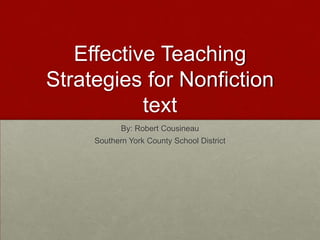
Effective Teaching Strategies for Nonfiction Text
- 1. Effective Teaching Strategies for Nonfiction text By: Robert Cousineau Southern York County School District
- 2. introduction Tell me about yourself: Content area? Grades you teach? Anything your students struggle with when it comes to reading nonfiction text?
- 3. It all starts with…
- 5. Having a “go to strategy” will save you time with planning.
- 7. Show your students the research that convinced us as educators.
- 8. President Obama using a reading strategy
- 9. Intro to Reading Strategies Talking to the Text – metacognitive (or think out loud) strategy. Summarization – we will explore a few summarization techniques. Document Based Questioning (DBQ) White-out Detective Method – more of a vocabulary based strategy but still used with class readings.
- 10. Talking-To-The-Text (TTTT) TTTT is a metacognitive strategy. This means that a student is going to actively think about what he/she reads (it holds them responsible!). Overall, it is a relatively easy strategy to incorporate in the classroom and most importantly, it is effective!
- 11. Here is how TTTT Works While students read, they think out loud by writing down their thoughts on the reading. Students will write in their comments in the margins or use sticky notes if there is not margin space. Students will need a TTTT prompt that will guide them in what type of comments to make.
- 12. Let’s practice the strategy Refer to handout #2-3. Find the TTTT bookmark. Let me demonstrate the first paragraph. Finish reading the article and TTTT at least seven times (an average of one time per paragraph). Share with the person next to you a few of your comments. Group discussion.
- 13. Let’s look at some student examples Take 30 seconds to look at each student example. I will indicate when to pass the student example.
- 14. Other examples of tttt See examples.
- 16. Set aside time to discuss comments as a class.
- 18. summarization This is an area of major concern with students. Our data shows that students struggle with summarization. There are multiple ways that students can summarize a text and I suggest you use them all. We will start with the 25 word abstract summary.
- 19. 25 word abstract summary A 25 word abstract summary is when a student will read a text and create a 25 word summary of the key points. It may sound simple, but students will struggle! It is critical that you spend time setting the students up for success.
- 20. Why do students struggle? Some students want to include details that are unnecessary – high achieving students commonly make this mistake. Solution: Demonstrate the strategy for the students a few times. For example… Some students only want to write the first sentence to each paragraph. Solution: Explain to the students that the first sentence typically introduces the paragraph and does not effectively summarize the paragraph. BIG PICTURE: This strategy takes time but will significantly improve student achievement in the area of summarization.
- 21. Let’s try IT! Refer to handout 5-7 Grab a highlighter. Read the handout and highlight key points. Work with a partner to write the 25 word abstract. After writing a rough draft, take a marker and write a final draft on a large piece of paper. Good luck!
- 22. Now Let’s look at a Student Example Refer to handout #8
- 23. Now Let’s look at other summarization strategies Refer to handout #9
- 24. White-out Detective method This method will help students with vocabulary and reading comprehension. The method is especially effective with more challenging readings. It requires some extra planning as a teacher, but requires little instruction to the students.
- 25. How to use Take a reading and white-out key vocabulary words or challenging words the students may not know. Define and discuss the words with the students before the reading is assigned. After the students finish reading, check and discuss student progress.
- 26. Let’s Try It! Refer to handout #10-11
- 27. Document Based Questions (DBQ) This strategy is primarily for the area of social studies because it focuses on primary sources. If there is ever a keystone exam in social studies, there will be a heavy focus on primary sources. With DBQ’s, students read primary sources and answer questions which assess their understanding of the sources. Then, students usually respond to a specific question that allows them to express their interpretation of the the source.
- 28. Review TTTT – Holds students responsible by having them think out loud. This strategy is an active learning technique which will increase reading comprehension. 25-word abstract summary – This strategy requires a good deal of instruction, but is important because data shows that our students are weak in summarization. White-out method – This strategy includes a lot of preparation on the teacher’s part, but will help with vocabulary and reading comprehension. This strategy is helpful with challenging readings.
- 30. Having a “go to strategy” will save you time with planning.
- 31. If possible, have your entire department on board with a “go to strategy” – even at the elementary level.
